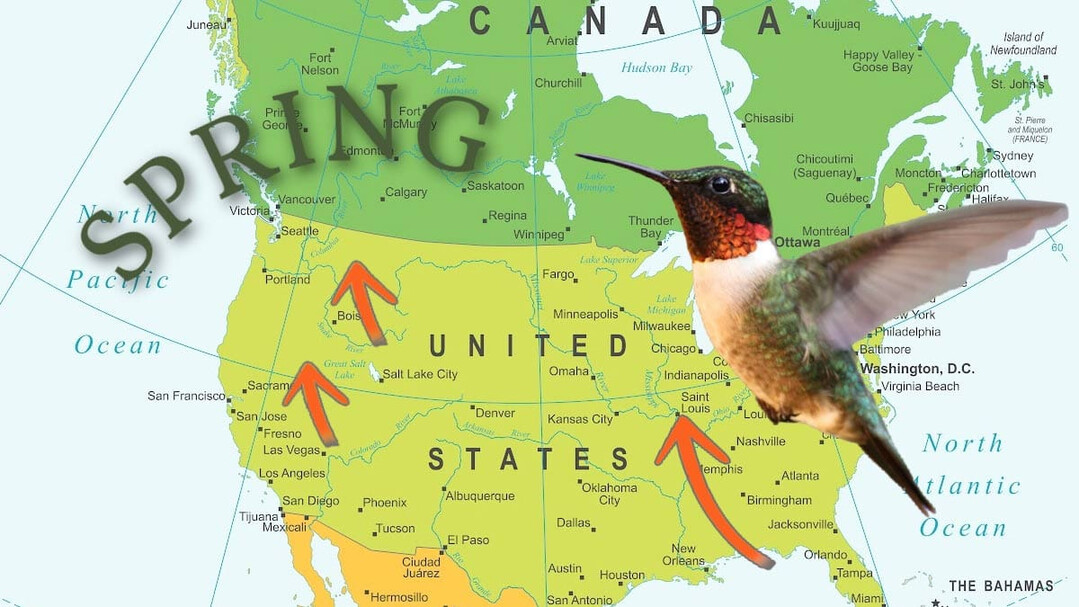
Every spring, tiny heroes with wings that beat too fast for the eye to follow and hearts that pound up to 1,260 times a minute, the hummingbirds, embark on their epic journey north.
These jewel-like, small but mighty birds are leaving their warm wintering grounds in Central America and undertaking the arduous journey to their summer breeding grounds across eastern United States and Canada.
Ruby-Throated Hummingbirds Arrive in Michigan... Chance to Spot Rare Visitors Too
According to the spring migration map of 'Hummingbird Central', a website tracking hummingbird migration routes, as of Saturday, April 12th, ruby-throated hummingbirds have been sighted as far north as Bloomington, Indiana, and Cincinnati, Ohio.
The ruby-throated hummingbird, the only native hummingbird species that breeds in Michigan, is found throughout the state in deciduous forests, forest edges, meadows, orchards, and gardens. Males have a brilliant orange-red throat patch, hence their name, while females have a white throat. Both males and females have metallic green backs and pale gray underparts with faint scale-like markings.
Bird information site 'avibirds.com' notes that Michigan also has the potential for sightings of five rare visitor species: △Rufous Hummingbird △Anna's Hummingbird △White-eared Hummingbird △Broad-billed Hummingbird △Violet-crowned Hummingbird, raising anticipation among bird enthusiasts.
Gaining Up to 40% Weight, Fluttering Solo Over 3,700km... Using Tailwinds to Conserve Energy
According to 'Hummingbird Central', hummingbirds increase their body weight by 25-40% before their long and challenging solo flights to prepare. They are active during the day during migration, flying at low altitudes to find nectar.
These tiny birds can travel up to 23 miles (about 37 km) a day, with their wings beating 15-80 times per second and their hearts reaching up to 1,260 beats per minute. Remarkably, hummingbirds are skilled flyers who expertly use tailwinds to conserve energy.
Climate Change, Habitat Destruction Threaten Hummingbird Survival... Urgent Need for Conservation Efforts
Meanwhile, hummingbirds face various threats due to their delicate ecological characteristics, including climate change and habitat destruction. Changes in flowering seasons, reduced food sources due to pesticide use, and deforestation negatively impact hummingbird survival. Experts emphasize the need for conservation efforts, including habitat preservation, as well as public interest and efforts such as planting hummingbird-friendly flowers in gardens and providing sugar water.
Reference Materials
Amazing Physical Abilities of Hummingbirds: Hummingbirds are among the smallest bird species and the only birds that can hover in mid-air. They can also fly backward and have incredible agility in changing direction at very high speeds.
Major Hummingbird Species: There are over 360 species of hummingbirds worldwide, mainly distributed in the Americas. In addition to the ruby-throated hummingbird, there are various species with brilliant colors, such as the ruby-topaz hummingbird and the sapphire-bellied hummingbird.
Symbiotic Relationship Between Hummingbirds and Plants: Hummingbirds use their long tongues and beaks to feed on nectar from flowers, and in the process, they transfer pollen, playing a crucial role in plant pollination. Certain plants and hummingbirds have very close symbiotic relationships.
Precautions When Observing Hummingbirds: When observing hummingbirds, it is important to watch quietly from a distance and avoid startling them or disturbing their nests. When providing sugar water, use clean water mixed with sugar and do not use honey or artificial sweeteners.
As the beautiful flight of the hummingbirds, which have begun their vigorous journey north this spring, continues successfully, efforts to protect these tiny creatures are becoming increasingly important.
[Copyright (c) Global Economic Times. All Rights Reserved.]






























